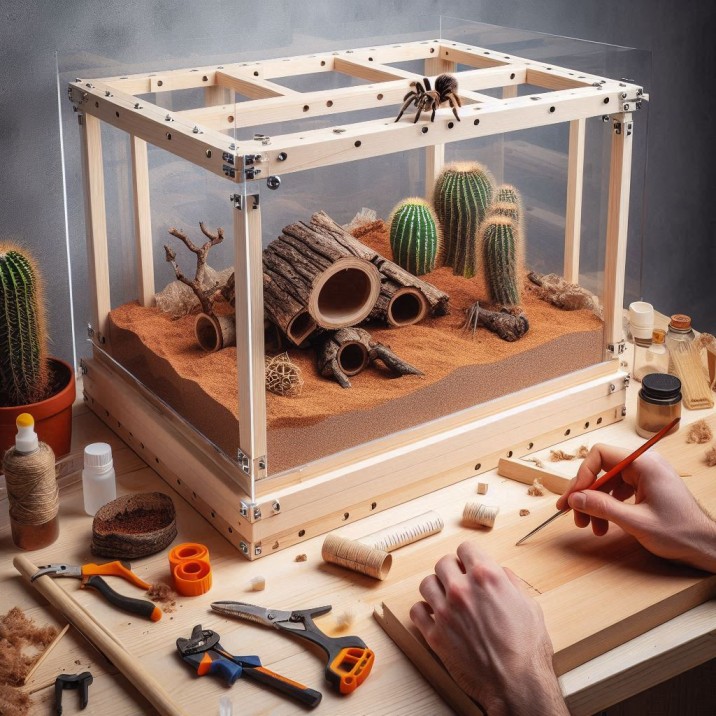Introduction
Table of Contents
Keeping a tarantula as a pet is an exciting and rewarding experience. One of the essential elements for maintaining the health and happiness of your eight-legged friend is providing a suitable enclosure. An acrylic enclosure is a popular choice among tarantula enthusiasts due to its durability, visibility, and ease of maintenance. This guide will walk you through everything you need to know about acrylic Tarantula enclosure, ensuring you create a safe and comfortable home for your arachnid companion.

Why Choose an Acrylic Enclosure?
Durability and Strength
Acrylic enclosures are highly durable and less likely to break compared to glass. This makes them a safer option, especially if you have curious pets or children around.
Visibility
Acrylic offers excellent visibility, allowing you to observe your tarantula’s behavior without any distortion. This is important for monitoring their health and well-being.
Lightweight and Easy to Move
Compared to glass, acrylic is much lighter, making it easier to move or reposition the enclosure as needed.
Easy to Clean
Acrylic enclosures are easy to clean, which is crucial for maintaining a healthy environment for your tarantula.
Setting Up Your Acrylic Tarantula Enclosure
Size Matters
Choosing the right size for your tarantula’s enclosure is crucial. The enclosure should be spacious enough for the tarantula to move around but not so large that it causes stress.
For small to medium-sized tarantulas, a 5-10 gallon acrylic enclosure is usually sufficient. Larger species may require a 15-20 gallon enclosure.
Substrate
The substrate is the material that lines the bottom of the enclosure. It should mimic the tarantula’s natural habitat. Common substrates include coconut fiber, peat moss, and soil. Ensure the substrate is deep enough for burrowing species.
Ventilation
Proper ventilation is essential to prevent mold and maintain air quality. Ensure the enclosure has adequate ventilation holes or a mesh top.
Hiding Spots
Tarantulas need places to hide and feel secure. Provide hiding spots using cork bark, hollow logs, or commercially available tarantula hides.
Water Dish
Always provide a shallow water dish for your tarantula. Ensure the water is clean and fresh.
Maintaining the Acrylic Enclosure
Cleaning
Regular cleaning is essential to prevent mold and bacteria growth. Clean the enclosure with mild soap and water, avoiding harsh chemicals that can harm your tarantula.
Temperature and Humidity
Maintain the appropriate temperature and humidity levels for your tarantula species. Use a thermometer and hygrometer to monitor conditions inside the enclosure.
Handling and Safety
Handle your tarantula with care, and avoid startling it. Always wash your hands before and after handling to prevent transferring oils or chemicals.
Common Issues with Acrylic Enclosures
Scratches
Acrylic can scratch easily. Use a soft cloth for cleaning to avoid scratches and maintain clarity.
Warping
Avoid placing the enclosure in direct sunlight or near heat sources, as acrylic can warp under extreme temperatures.
DIY Acrylic Enclosures
For those who enjoy a DIY project, building your own acrylic enclosure can be a fun and rewarding experience. Ensure you have the proper tools and materials, and follow a detailed guide to ensure the safety and comfort of your tarantula.
Conclusion
An acrylic enclosure is an excellent choice for housing your tarantula, offering durability, visibility, and ease of maintenance. By following the guidelines provided in this article, you can create a safe and comfortable home for your arachnid companion, ensuring they thrive in their environment. Happy tarantula keeping!
Table of Information
| Feature | Details |
|---|---|
| Material | Acrylic |
| Size | 5-20 gallons, depending on tarantula size |
| Substrate | Coconut fiber, peat moss, soil |
| Ventilation | Adequate ventilation holes or mesh top |
| Hiding Spots | Cork bark, hollow logs, commercial hides |
| Water Dish | Shallow dish with clean, fresh water |
| Cleaning | Mild soap and water, avoid harsh chemicals |
| Temperature | 70-85°F (21-29°C) |
| Humidity | Specific to tarantula species, monitored with a hygrometer |
FAQs
1. How often should I clean my tarantula’s acrylic enclosure?
You should clean the enclosure every 2-4 weeks, depending on the size and activity level of your tarantula.
2. Can I use sand as a substrate in an acrylic enclosure?
Sand is not recommended as it does not hold moisture well and can be abrasive to the tarantula.
3. How can I prevent scratches on the acrylic enclosure?
Use a soft cloth for cleaning and avoid abrasive materials to prevent scratches.
4. What is the ideal temperature for a tarantula in an acrylic enclosure?
Most tarantulas thrive at temperatures between 70-85°F (21-29°C).
5. Can I build my own acrylic enclosure?
Yes, building your own acrylic enclosure is possible with the right tools and materials. Follow detailed guides to ensure safety and comfort for your tarantula.

